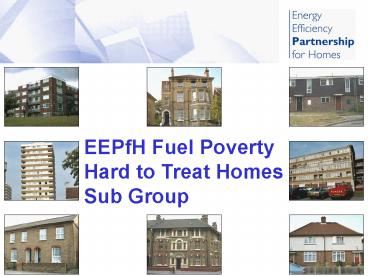EEPfH Fuel Poverty PowerPoint PPT Presentation
1 / 15
Title: EEPfH Fuel Poverty
1
EEPfH Fuel Poverty Hard to Treat Homes Sub Group
2
Remit of the Group
To investigate and promote means to improve the
energy efficiency and eradicate fuel
poverty within properties that are
considered hard to treat
What is hard to treat?
3
What is hard to treat?
hard /had/ adj., adv., n a. difficult to
understand or explain b. difficult to
accomplish c. not easy to
Practicably achievable now
Impossible at anytime
4
What is hard to treat?
Expensive
In relation to established cost effective
insulation And heating measures.
Technically challenging
In application, either due to the physical nature
of the dwelling (architecture and/or disrepair)
and its environment.
Legally challenging
In application, due to issues of ownership,
responsibility for property and planning.
5
Or to put this simply
Any dwelling that for whatever reason cannot take
full advantage of the currently available cost
effective energy efficiency improvements.
By cost effective we mean, in terms of
installation, and running costs for the occupier.
6
Background to the Hard to Treat Sub -group
April 2002 EEPfH Fuel Poverty Sector Working
Group begins to form the Difficult Properties
sub-group.
June 2002 First meeting of the sub-group, now
being called Hard to Heat or Hard to Treat.
Group composition and workplan agreed.
2002-03
- The work of the group focuses on using existing
data - to determine the prevalence of fuel poverty in
hard to treat - homes.
- Work on the Matrix starts.
- Reports are commissioned on the practical
approaches - being employed within social housing and the
technologies - being used.
7
Background to the Hard to Treat Sub -group
- Group Membership
- Charitable and voluntary organisations
- Energy suppliers
- Government, particularly the Department for Trade
and Industry - Energy Action Scotland
- Professional and trade organisations
- EST
8
Background to the Hard to Treat Sub -group
Publications 2002-03
- Hard-to-treat homes guideAn overview of the
measures required to tackle hard-to-treat homes
is available to local authorities. This gives a
broad indication of their relative effectiveness
in addressing fuel poverty. - http//www.est.org.uk/uploads/documents/partnershi
p/Practical20Help20-20Hard20to20Treat20Guide
.pdf
- Hard-to-treat homes reportThe hard-to-treat
homes sub-group of the Partnerships Fuel Poverty
group commissioned research looking into local
authority activity to tackle fuel poverty in
hard-to-treat properties (essentially those with
solid walls or off the gas network). - http//www.est.org.uk/uploads/documents/partnershi
p/Complete_Final_Report_Full.pdf
9
Background to the Hard to Treat Sub -group
April 2003 EAS is elected by the members of the
group to Chair the sub-group sessions.
2003-04
- The work of the group focuses on the specific
challenges with particular technologies, and
modelling running costs with common hard to treat
flats.
- Work on the Matrix continues.
- Reports are commissioned on solid wall insulation
for both - policymakers and housing authorities.
10
Background to the Hard to Treat Sub -group
Publications 2003-04
INSULATING SOLID WALLS - A challenge for policy
makers and scheme managers An examination of the
policy issues regarding the increased uptake of
solid wall insulation. http//www.est.org.uk/uplo
ads/documents/partnership/Solidwalls_Policy_Final1
INSULATING SOLID WALLS - A challenge for local
authorities and housing associations A report
which seeks to provide impartial, practical and
user-friendly information on a number of specific
solid wall insulation technologies. http//www.est
.org.uk/uploads/documents/partnership/solidwallsLA
1.pdf
Comparison of running costs for different heating
options in hard to treat flats An estimate of
comparable running costs in hard to heat flats
supplied by different heating systems. http//www.
est.org.uk/uploads/documents/partnership/H2T20fla
ts20report20Mar042.pdf
11
Background to the Hard to Treat Sub -group
2004-05
- The work of the group focuses on those specific
technologies, where a comprehensive knowledge of
application and benefits are relatively unknown.
This focusses on heat pump technology.
- Work continues on filling the Matrix and
expanding - its functionality.
- Policy research focuses on providing a critical
analysis - of the prevalence of non-traditional housing in
the UK, and - of the likely incidence of fuel poverty within
them.
- The group liaises closely with DTI, DEFRA and the
- DTIs Design and Demonstration Unit to ensure
that the - proposed workplan will be informative and does
not - duplicate other work proposed or completed.
12
Background to the Hard to Treat Sub -group
Publications 2004-05
Fuel Poverty and Non-traditional Constructions An
investigation of the current prevalence of
non-traditionally constructed properties in the
UK and the risk of fuel poverty within them.
Identify examples of best practice and potential
case study areas. http//www.est.org.uk/uploads/do
cuments/partnership/FP20NTrad20report_Final1.pdf
UK Heat Pump Study A comprehensive review of the
application of heat pump technologies for heating
domestic properties in the UK. Outline guidance
to local authorities, architects and house
developers on the use of heat pumps and hard to
treat homes. http//www.est.org.uk/uploads/documen
ts/partnership/Heat20Pumps20Study20Report20fir
st20version.pdfhttp//www.est.org.uk/uploads/doc
uments/partnership/HTT20Heat20Pump20Guidance20
-20final20version.pdf
13
Background to the Hard to Treat Sub -group
The Matrix
Can be found at http//www.est.org.uk/housingbui
ldings/calculators/hardtotreat/
14
Hard to Treat Sub group 2006-07
Does Biomass offer a viable means to tackling
rural fuel poverty? What are the challenges in
supporting an effective fuel supply network?
There are now a range of small scale wind
generators that are market ready and being
supported by fuel utilities. What are the
benefits to the householder, and what barriers
still exist to installation?
Clearly, the insulation of solid walls and flat
roofs has a role to play in the eradication of
fuel poverty by 2016. Following on from the sub
group reports on solid wall insulation, what
needs to be done to transform the industry to
mainstream this measure.
15
Questions?

